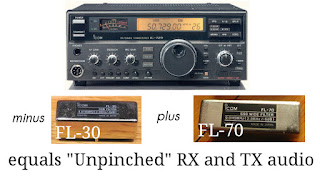Replacing the FL-30 with the wider FL-70 in my IC-729
A few days of trying out the new wider bandwidth filter has led me to the conclusion that fine tuning of the BFO frequency is mandatory after every IF filter replacement. I had previously done a filter change on a TS-140 and to get the same result I had to adjust the exact BFO frequencies for USB and LSB. The Kenwood and the Icom require different procedures because they are constructed differently but the the aim of the BFO adjustments is the same: shift the sideband envelope so that it fits the window presented by the new filter, with due regard to the desired audio frequency response. Some operators have a higher pitched voice while some have lower pitched (bassy) voice. Aside from the selection of microphone, an adjustment of the BFO injection frequency can modify performance of the IF filter to do a low cut or boost or high cut or boost. There are several ways to implement BFO offsets. We myst remember that offsetting is a necessity unless there are separate IF filters for USB, LSB and CW. The Collins KWM-2 is an wxample. Modern radios keep costs down by using the same filter for USB and LSB and merely offset the BFO frequency to choose the sideband that will pass through the single filter. For ofsetting the BFO, the Icom IC-729 has a trimmer cap for USB, and adjustable core inductors for the CW and LSB setting. The Kenwood TS-140 uses a set of trimmer resistors and an A/D system. No doubt more modern designs include the capabilty to do this via a menu. For the ic-729, I adjusted the USB frequency by first setting it to the recommended frequency and then trimming it while transmitting to a dummy load and at the same time monitoring the output with a receiver. The frequency at the output band will be uncalibrated so just tune (clarify) with the receiver until you get the desired passband shape (bass and treble content, etc). You can then do the DDS (Direct Digital Synthesizer) adjustment to bring the signal back into calibration. Essentially, the DDS compensates for the BFO offset). The DDS adjustment is described in the user (not service) manual and starts with the "power on while pressing func and rit button" sequence. After the USB, the CW and finally the LSB settings are adjusted. If you are nervous, DO NOT TRY THIS. With some older radio designs, you might have to choose which sideband will be bassy and which will be treblish. Yes some radios will give unsymmeterical response (USB vs LSB) while some can give symmetrical response.




Mga Komento
Mag-post ng isang Komento